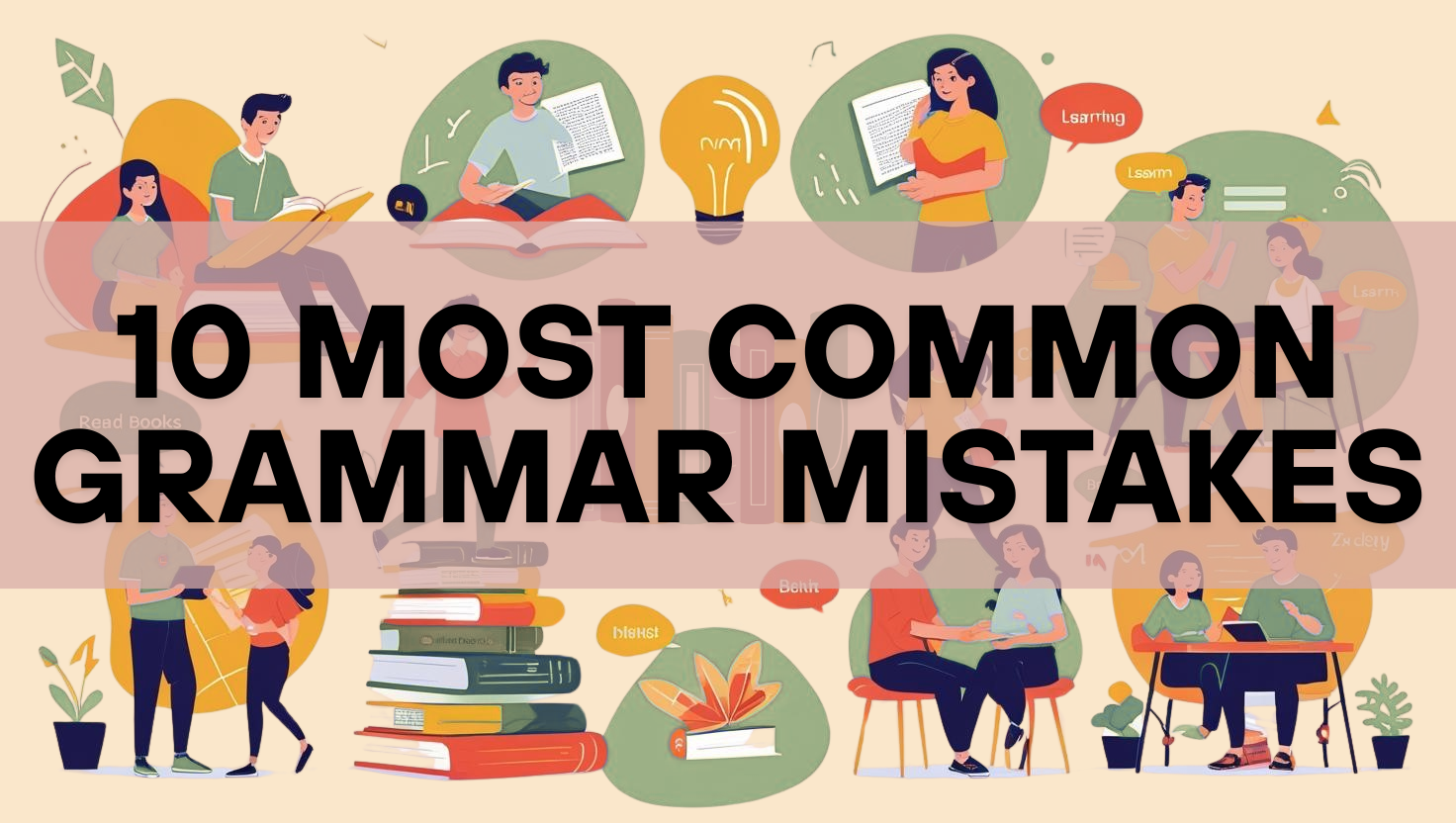Discover the 10 most common grammar mistakes English learners make—explained with simple examples and clear tips to help you speak and write more confidently in English.
So learning English can feel like a rollercoaster. Some days everything clicks, and other days, grammar rules seem to change the moment you think you’ve got them down. The truth is, even advanced learners sometimes fall into common grammar traps. But here’s the good news: once you know what to look out for, these mistakes are easy to fix. Let’s dive in!
1. Mixing Up “Your” and “You’re”
Let’s start with one of the most common and confusing pairs in English—your and you’re. They sound the same but have totally different meanings.
- Your is a possessive adjective (it shows something belongs to you):
“Your phone is on the table.” - You’re is a contraction of you are:
“You’re going to love this movie.”
How to fix it: Try saying “you are” instead. If the sentence still makes sense, you should use “you’re.”
✅ Correct: “You’re amazing!”
❌ Incorrect: “Your amazing!”
2. Confusing “Their,” “There,” and “They’re”
Another triple threat! These homophones often trip people up.
- Their = belongs to them: “Their dog is friendly.”
- There = refers to a place or is used as a filler: “The book is over there.” / “There is a problem.”
- They’re = they are: “They’re going to the park.”
Quick tip:
If you can replace the word with “they are,” use they’re.
If you’re talking about ownership, use their.
For places or general statements, go with there.
Still getting confused between there, their, and they’re? You’re not alone — it’s one of the most common mistakes English learners make. Check out this short poem to help you. But if you want a fun way to test your knowledge, check out my There, Their, They’re Boardgame, designed to help you master it once and for all!
3. Using the Wrong Verb Tense
English has a lot of tenses, and it’s easy to mix them up—especially when talking about past experiences.
Example mistake:
❌ “Yesterday I go to the mall.”
✅ “Yesterday I went to the mall.”
Tip: When talking about the past, most verbs need to be changed to their past tense form. Regular verbs usually add -ed, while irregular verbs (like go → went) need to be memorized.
To stay on track, practice speaking in different tenses out loud. For example:
- I eat breakfast every day. (present)
- I ate breakfast yesterday. (past)
- I will eat breakfast tomorrow. (future)
4. Forgetting the -s in Third Person Singular
This is one of those tiny details that make a big difference.
Mistake:
❌ “She walk to school every day.”
✅ “She walks to school every day.”
Rule: In the present simple tense, when the subject is he, she, or it, the verb usually needs an -s at the end.
This rule can be tricky because it doesn’t apply in all tenses, but for present simple sentences, it’s key!
5. Incorrect Word Order in Questions
English questions often follow a specific word order—usually starting with a helping verb or a question word like what, where, or why.
Common mistake:
❌ “You are coming?”
✅ “Are you coming?”
Another example:
❌ “Where you are going?”
✅ “Where are you going?”
Quick fix: For yes/no questions, invert the subject and helping verb:
- Statement: “You are tired.”
- Question: “Are you tired?”
6. Overusing or Misusing Articles (a, an, the)
Articles are small but mighty—and they often cause confusion.
- “A” is used before words that begin with a consonant sound: a dog, a car, a university (sounds like “you-niversity”)
- “An” is used before vowel sounds: an apple, an hour (the “h” is silent)
- “The” is used when referring to something specific: the sun, the best day ever
Mistake example:
❌ “I saw an dog at the park.”
✅ “I saw a dog at the park.”
7. Using Double Negatives
Double negatives might sound okay in some languages, but in English, they cancel each other out—and make the sentence incorrect.
Example:
❌ “I don’t know nothing.”
✅ “I don’t know anything.”
Why?
“Don’t” is already negative, so adding “nothing” makes it confusing. Instead, pair negatives with positive words like “anything” or “anyone.”
8. Incorrect Preposition Use
Prepositions are tricky because they don’t always follow a clear pattern. Common ones like in, on, at, for, and to are often mixed up.
Examples:
❌ “I’m good in English.”
✅ “I’m good at English.”
❌ “She’s married with a doctor.”
✅ “She’s married to a doctor.”
Tip: Learn prepositions through phrases, not individual words. Phrasal verbs and collocations (word pairs) can help you remember the right combinations.
9. Forgetting to Use the Subject
In English, every sentence needs a subject. Unlike some languages, English doesn’t usually drop the subject—even when it’s obvious.
Mistake:
❌ “Is raining today.”
✅ “It is raining today.”
Even when the subject seems unnecessary, English still requires it. Think of “it” as a placeholder subject in weather expressions.
10. Misplacing Adverbs
Adverbs (words like always, never, often) can go in different places—but they often come before the main verb or after “to be.”
Examples:
✅ “She always drinks coffee in the morning.”
✅ “They are never late.”
Mistake to watch for:
❌ “She drinks always coffee.”
✅ “She always drinks coffee.”
Bonus tip: Adverb placement can sometimes change meaning, so double-check where it naturally fits.
Final Thoughts: Practice Makes Progress
Making grammar mistakes is totally normal—it’s part of the learning journey! The key is to recognize the patterns, understand the “why” behind the rules, and practice in real-life situations.
English learners can speed up their progress by:
- Reading English books or blogs (like this one!)
- Watching shows with subtitles
- Speaking out loud and recording themselves
- Getting feedback from native or fluent speakers
And most importantly—don’t be afraid to make mistakes. Every slip-up is a step toward mastery!
Want More English Tips Like This?
If this post helped, there’s so much more where that came from! Stick around for:
- Easy grammar breakdowns
- Real-life conversation guides
- Fun learning tools like quizzes, stories, and vocabulary games
Subscribe to the blog or follow on YouTube for weekly lessons designed to make English fun, friendly, and practical for everyday life.

